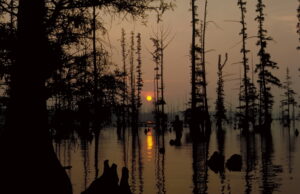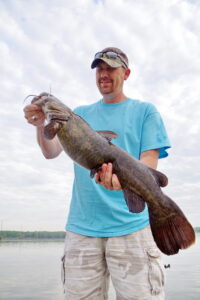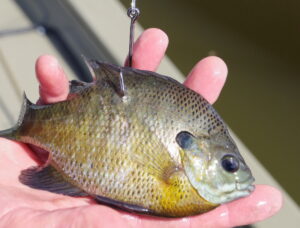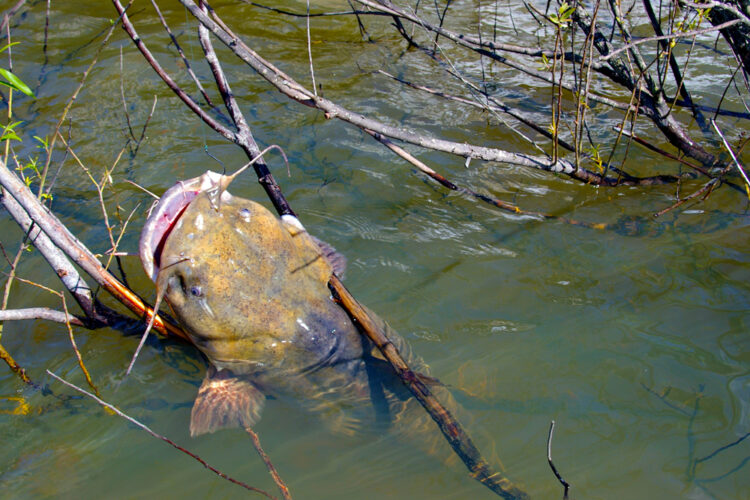An abundance of dense woody habitat in Lake Conway creates a haven for big flathead catfish. (Photo: Keith Sutton)
Arkansas Honeyhole for Monster Flatheads: Lake Conway
by Keith “Catfish” Sutton
If you’re looking for a place where you can catch big flatheads, consider central Arkansas’ Lake Conway.
So, you’re wanting to catch a trophy-class flathead catfish. That’s a praiseworthy goal. These beasts commonly exceed 50 pounds. World-record-class fish top 120. If you’re shrewd enough to hook one, it will definitely test your grit. Monster flatheads break lines, burn drags and destroy tackle. The unprepared angler may see his favorite rod and reel snatched right out of his hands and plunged beneath the water’s surface, never to be seen again.

Success requires not only strong tackle and a secure grip, however, but also a knowledge of prime waters where big flatheads thrive. Lake Conway in central Arkansas is one such body of water.
Although it is officially recognized as Craig D. Campbell Lake Conway Reservoir, locals have always known it simply as Lake Conway. It has the distinction of being the largest lake ever constructed by a state game-and-fish agency. This sprawling impoundment, 25 miles west of Little Rock on Interstate 40, covers 6,700 acres.
While its size is impressive for a state-owned lake, the lake’s dimensions are not its only distinction. Conway also is one of the stumpiest lakes in the country. When the Arkansas Game and Commission impounded Palarm Creek to create Lake Conway in 1948, it flooded a huge area of standing and cut-over timber. The result was a lake chock-full of dense woody cover.
The stumps, logs and snags in Lake Conway also created a haven for cover-loving flatheads. These big-mouthed catfish are extraordinarily plentiful here and often tip the scales at 5 to 25 pounds. Even bigger specimens are regularly caught by local anglers, with several reports of 50- to 80-pound heavyweights coming from the lake each year.
You won’t see many photos of those fish posted online, but that’s because the folks who catch them would prefer you don’t know about this extraordinary honeyhole, which until now has remained largely undiscovered by outside anglers. Nevertheless, some ardent flathead fans believe if a flathead bigger than the current 123-pound, 9-ounce world record ever is caught, it is likely to be caught in Conway.
One reason Conway is a haven for flatheads is abundant forage. Healthy populations of sunfish, shad and channel catfish provide a bounty of food, allowing flatties to stay well fed, reproduce well and reach their maximum size potential. Live bluegills, green sunfish, longear sunfish and redears are the baits of choice for most local anglers, a few of whom fish with rod and reel, but many of which use trotlines, limb-lines or yo-yos.

Because the lake bottom has such a dense blanket of cover in all areas except Conway’s boat lanes, it can be tough to fight and land a big flathead with a hand-held pole. Set lines, however, can be placed in locales where fish will tire as they fight against the hook, increasing the odds of landing a true giant.
Because most Conway flathead aficionados are secretive about the location of their favored honeyholes, it can be hard for a first-timer to locate an area harboring big flatheads. One good way to do this is to spend time studying the interactive lake map and additional information available on available on the Arkansas Game and Fish Commission website at https://www.agfc.com/en/zone-map/fishing-map/579/.
The map shows the location of numerous fish attractors sunk in key locations throughout the lake. These attract schools of sunfish, which in turn attract hungry flatheads. Just drop a live baitfish to the bottom adjacent to one of these brushpiles for a good chance of quick action.
The map also shows fishing piers and bank-fishing access areas that are ideal for night-fishing forays (daytime, too, of course). And each boat ramp/launching area is marked as well. Most importantly, perhaps, the map shows all the lake’s boat trails, which were recently cleared and marked so boaters can navigate through Conway’s maze of underwater timber. Boaters leaving the trails should navigate cautiously. Many stumps and logs lie unseen just below the water’s surface, making spare shear pins essential gear here.
On the map page is another invaluable tool for Lake Conway visitors. In the section of text labeled “District Information,” you will see a link that says, “Fish Successfully on Lake Conway.” This leads to several pages of excellent information compiled by the lake manager and area fisheries biologists. Included is a map titled “Old Ponds, Deep Water Habitat” showing the location of some old lakes inundated when Conway was filled. Flatheads prefer the sanctuary these deep areas offer, so knowing the lakes’ locations can give you a good start on catching some trophy-class fish.
Art’s Pond, Gold Lake, Adam’s Lake and Green’s Lake are all excellent locations for placing a trotline or baitfishing with a rod and reel. Deeper water in the creek channel adjacent the Highway 89 bridge on the south end provides another prime spot for catfishing as well.

If you want to know more, you can contact Game and Fish personnel who work on the lake through the District 10 fisheries office in Mayflower. Go to 213 A Highway 89 South, or phone 1-877-470-3309.
Visitor Information
Lake Conway is ringed with excellent commercial fishing docks catering to visiting anglers. Many offer boat and motor rental, and some have rustic cabins and campsites for rent at a reasonable price. Restaurants and lodging are available in nearby Mayflower and Conway.
Exit 135 (Mayflower) on Interstate 40 between Little Rock and Conway offers access by way of State Highway 365 to docks on the west side of the lake, or by State Highway 89 and Clinton Road to docks on the east side. Fishing regulations for the lake, and information for purchasing licenses, can be found on the Arkansas Game and Fish Commission’s website, www.agfc.com.



